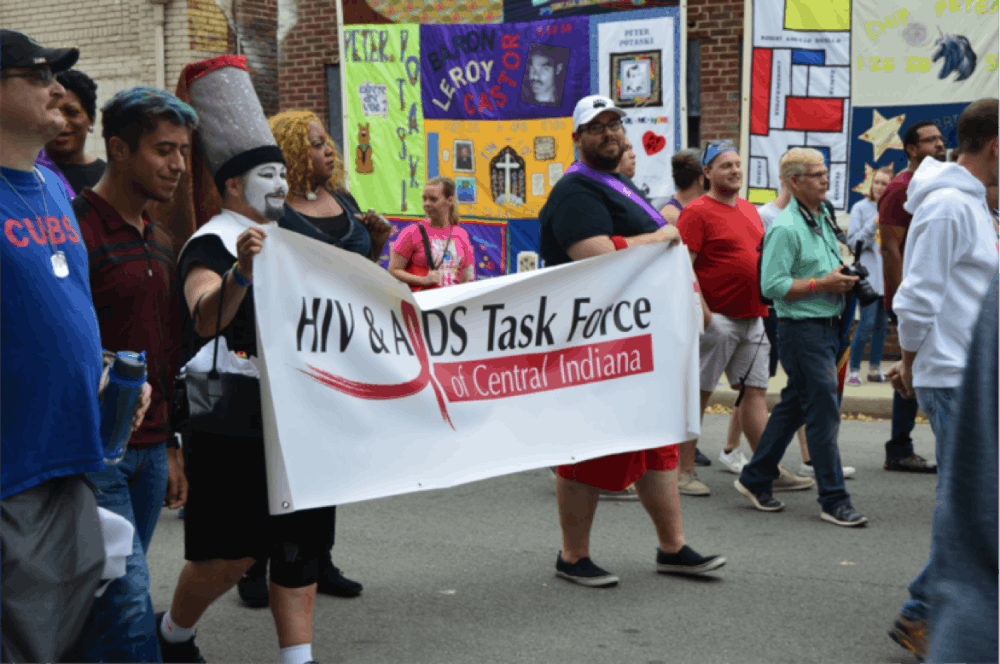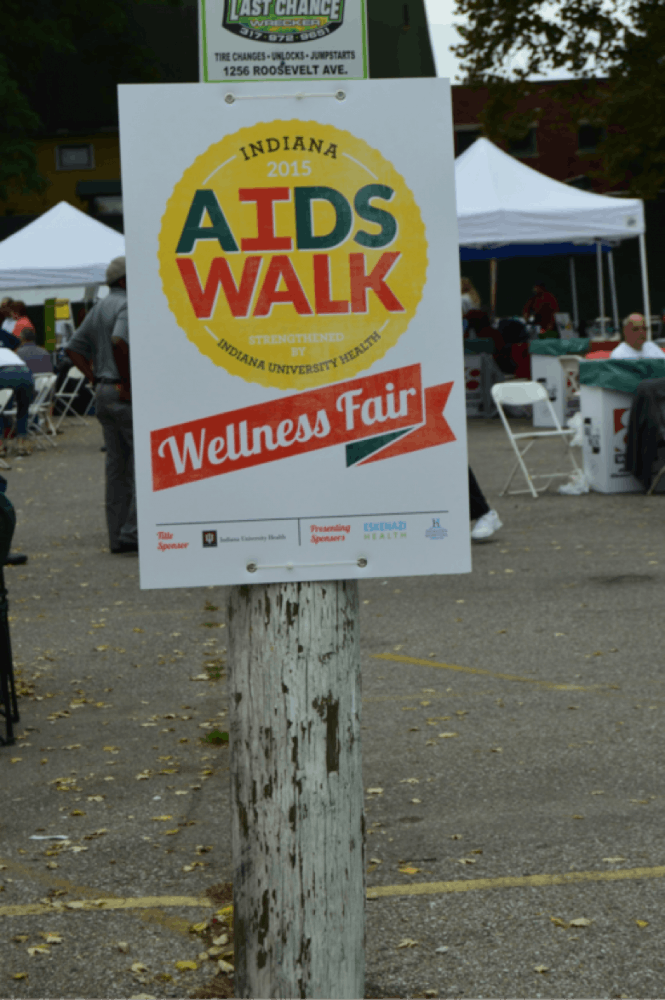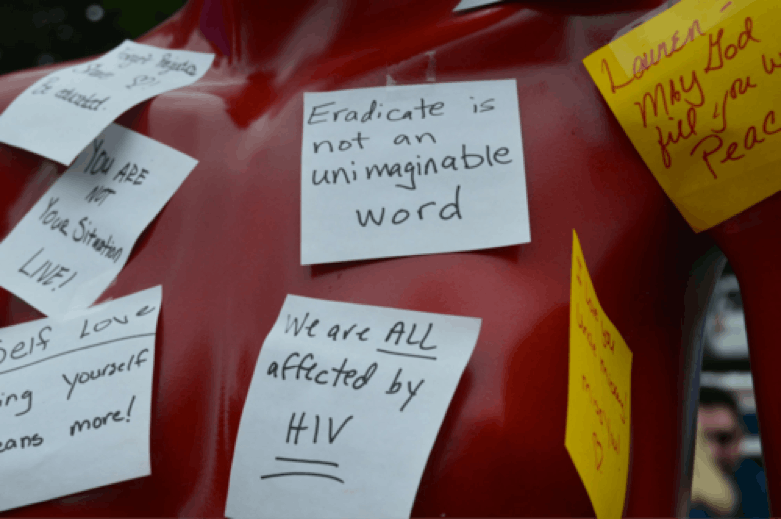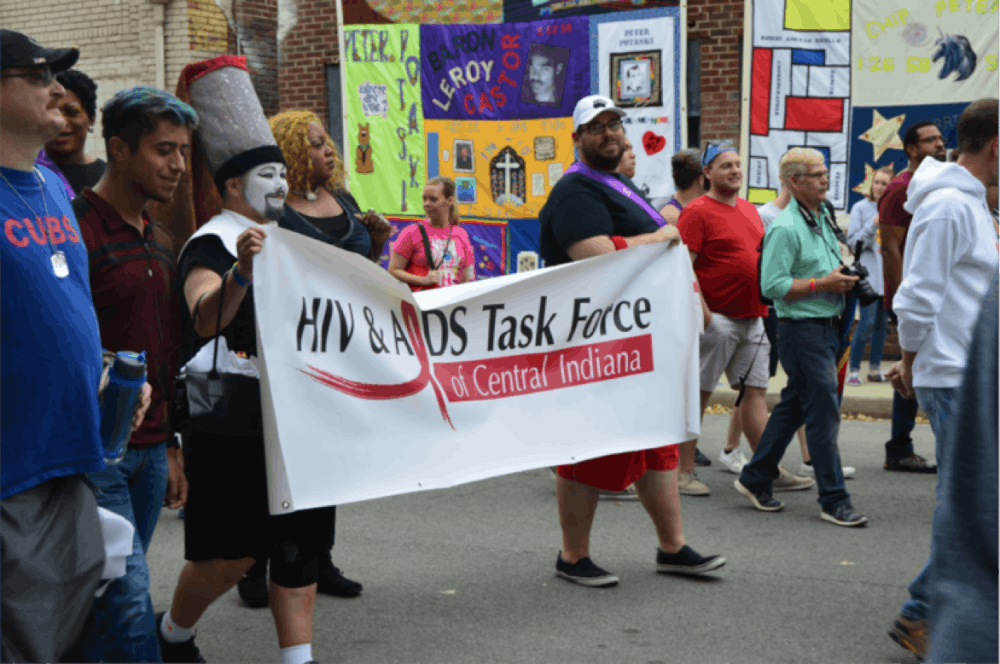The 25th Indianapolis AIDS Walk brings community together to end the stigma.
By Breanna Cooper
In the 1980s, a positive HIV test result signaled the beginning of the end. Within months, the infected individual whittled away to skin and bones, developing sores and awful bouts of pneumonia. From 1981 to current day, the CDC estimates that 658,507 Americans have lost their lives as a result of HIV/AIDS. Thanks to modern medicine and the tireless efforts of early patients, someone with HIV can lead a normal and healthy life. Despite this progress, many people around the world remain in the dark when it comes to their awareness of HIV. With a stigma still ever present, the annual Indiana AIDS Walk is fighting to shine a light on what life is like for HIV-positive Hoosiers.
With huge crowds of people gathering in Herron Morton Place neighborhood on Saturday, Sept. 25, participants in the walk received information from organizations such as Planned Parenthood, The Ryan White Foundation, and many others on the prevention and awareness of HIV along with many other sexually transmitted diseases and infections.
Despite the fact that the gathering was organized to spread awareness of HIV/AIDS, the feeling of hope was evident. There is good reason for that. Although HIV is a serious illness, the progress that has been made over the past two decades has made it possible for those with the illness to be able to share their stories, some of which began 15 years ago. This feat would have been unheard of just 30 years ago.

Jason and John took part in the 25-year event. A couple for the past three years, both have firsthand knowledge about what it’s like to live with HIV but, more importantly, understand that a normal life no longer ends with a positive test result.
“I found out [my positive status] through my family physician, just a regular test,” Jason said. “It changes the way you think, the way you do things. You’re a little more conscious of making sure you’re taking care of yourself, so you’re not affecting those who aren’t HIV-positive. It’s a life changer. So much has been done in the last 10 through 15 years that it’s no longer scary. I was scared when I was first diagnosed, but I wasn’t educated.”
And that education is a mission of the AIDS Walk.
“And that’s another thing about events like this: it helps educate people and let them know what to do when they discover their positive status,” Jason continued. “Now, five years later, I’m here as an advocate, to help raise money, help spread the word about what it is and who can help.”
By raising awareness of HIV, a community inherently helps to raise support for the members living with HIV.
“For me,” John said, “it’s support for him. It gets the community involved. I mean, I’ve posted it all over facebook for the past several weeks. It started small, but it’s getting bigger. Word is getting out; we just need to get it out more.”
The evolution of research on and treatment of HIV over the past two decades is astounding. While there is currently no cure, there are precautionary methods, besides the use of condoms, that can help prevent the virus from spreading.

“PrEP is Pre-Exposure Prophylaxis,” John explained, “which means you take a daily tablet. The brand name is Truvada. It’s an HIV medication. With clinical results, it’s a 99.99% barrier against HIV. So, your chance of getting HIV is basically zero to none. So, it’s an extra precaution for you whether you’re in a discordant couple like we were--one positive, one negative--or if you involve yourself in risky sexual behavior or if you are an intravenous drug user. It’s just an extra precaution to help yourself.”
However, before John could begin taking PrEP, a visit to the doctor revealed a change in his status.
“I was diagnosed in February,” John explained. “We went in for a routine test, I was going to get on PrEP just as an extra cautionary method for us, and my result came back positive. I was like, ‘okay.’ I knew it was a risk three years ago when we started dating, and it doesn’t bother me.”
As a college student, there are some aspects that John views differently, but overall he does not believe that his status makes an overwhelming impact on his college experience.
“In some ways it has changed the way I look at college and college activities. But, as an everyday, general thing, no. I do keep a small first-aid kit in my backpack just in case I get cut, but it's something I did keep with me even before I became HIV-positive.”

“Back when you had to wait 72 hours for an HIV test result,” John explained, “you racked your brain. ‘Well, what if this, what if that,’ so I had already went through all of the emotions. I’d already went through the denial, the anger, all of that. I was just like, ‘alright, it’s the next step in life.’ I dealt with that when I was 19 with my first HIV test. So, having that when I was younger, being diagnosed in February, I was just like, ‘okay. What’s next?’”
“But, we were together for two years when he found out he was positive,” Craft pointed out. “So, in the early stages of dating, it was one of the first things I said, from the get-go. You know, he’s going to school for public health; he wants to be leading these events, an advocate for people. Yes, he had a moment, everyone has a moment. But it’s short-lived. It’s like, ‘okay, what do we do next?’ Within a day or two, he was fine, back to normal.”
While the general public seems to grasp the idea that you cannot contract HIV from a handshake or sharing utensils, the stigma that surrounds HIV is still prevalent. When asked whether or not HIV-positive individuals are ostracized when others find out about their status, Jason and John had a unanimous answer: “yes.”
“Education can change that,” John said. “The more people are educated, the wall of stigma gets a little bit weaker.”
“And even the education of PrEP and what PrEP is,” Jason added. “That alone changes so much. You know, the way that it works, and I think teaching people what to do to prevent it [also helps]. It’s not just condoms, it’s a lot of other things.”
Along with misinformation among the public, the taboo surrounding sex and drug use also plays a huge role in the stigma that surrounds HIV.
“People think only homosexual men can get it, but it’s not just homosexual couples,” Jason said. “It’s straight, and bi, gay, whatever. It’s drug users that share needles, and there’s so many different ways that you can transfer HIV to someone else.”

“I think if we can break the stigma,” John started, “that it’s only with this population... it’s not, it’s across the board now. If we can break the stigma that it’s a dirty disease or a “you’re done” disease, or it’s a going-to-kill-you disease. If we can break that, then I think society as a whole would embrace it a little bit more.”
Perhaps one of the most notable differences between the treatment of HIV now as opposed to in previous years is the medication options. Thanks to medicinal research and the efforts of early AIDS patients fighting to use experimental drugs, HIV-positive individuals now have treatment options that allow them to take one pill a day to treat the infection.
“I’m one pill a day,” John explained. “It’s a combo drug; it’s got three drugs in it. Once a day, a minimum of 400 calories, that’s it. Just once a day. No side effects, really.”
“And I’m the same way,” Jason said. “We’re on different medications, but what they do is very similar. I’ve done Atripla, and my body became immune to it--it quit working for me. My counts were crazy, and I was put on a cocktail. Three different drugs, nine pills a day. Two in the morning, two in the afternoon, you know, and it was dumb.”
“And now I’m back to one pill a day,” Craft continued, “and for me, that’s what makes it so easy to cope and deal. When I was on that cocktail, my day was surrounded by that. It’s all that I thought about and dealt with. Now that we’re on one pill, we have dinner, ‘hey here’s your drug,’ we both take it, and we are taking care of ourselves and each other.”
“The riots at the FDA in the late 80s/early 90s are where we get our medications today,” John said. “If those people hadn’t stepped up for us and our futures to say, ‘hey, we’re suffering too,’ we wouldn’t have them.”
“Well, there’s government funding for it now,” Jason added, “and there wasn’t back then. So, until the mid-80s, there was nothing. And it was grassroots efforts in attempt to find a cure, or just something to decrease it.”
As treatment options are increasing and the quality of an HIV-positive individual is not diminished, many people are hopeful that a cure may be found in the near future.
“We went from it being classified as an infectious terminal disease to a communicable contained disease,” John said. “Studies now are saying HIV-positive men are living as long or longer than their negative counterparts due to the drugs and the leaps and bounds they’ve taken to suppress things but at the same time boost the things that help exponentialize all of that.”
“With the way research and medications are evolving, there may not be a cure, but there may be a vaccine, but who knows,” John continued. “We’ve made leaps and bounds over the last ten or fifteen years, so in the next decade we could see one.”
Until the day that there is finally a cure for HIV, organizations like the Damien Center and the Ryan White Foundation will be there for HIV-positive Hoosiers. Not only do they provide medical assistance, but they also take care of the emotional and social problems that may affect those living with HIV.
“They have counseling services,” John said. “So, if you’re at a point where you don’t know what to do emotionally or mentally, they have places to go and people you can talk to. And it’s safe. That’s the whole thing with this community. Not just breaking down the stigma, but making the people in the community feel safe and accepted. Not degraded, belittled, or anything like that.”
“When you get your diagnosis,” Jason explained, “whatever doctor or clinic or whoever does it, they, by law, have to report it to the Health Department, Marion County. They usually reach out to make sure that you have insurance or care. I’ve been fortunate enough, until now, that I didn’t need these services. They make sure you have, or at least are aware of, the help that is out there.”
“The Ryan White Project, Step Up, The Damien Center, all of them provide care coordination services, which are medical, doctors appointments, drugs, housing, food pantries, electric bills,” John said. “So, there are programs out there for HIV-positive people, but they need to go in search of them.”
Unfortunately, things like housing and bills can be a big issue for those living with HIV. Although stigma may be decreasing, HIV in a professional setting can be a risky subject to discuss.
“For most HIV-positive people, in their professional lives, it’s never spoken of,” John explained. “As for their personal lives, that’s a different story. I think if people were more open about it, there would be more conversation, but at the same time you also have to look at your professional standpoint and say, ‘I could lose my job, that means I could lose my house, lose everything that’s keeping me healthy.’ So, it’s a balancing act that we have to follow.”
Although there are protections for people with HIV and other illnesses against unfair treatment in the workplace, Indiana law provides a loophole for businesses to get through.
“Indiana is an at-will state,” John explained. “So, your employer can walk in and say, ‘I don’t like your shirt, you no longer have a job.’ So, they can fire you for any number of reasons that they want to and just say, ‘we’re an at-will state.”
For 25 years, the Indiana AIDS Walk has been helping organizations, such as the Damien Center, reach out the HIV-positive Hoosiers who may be struggling to make ends meet. Due to recent circumstances, Jason has worked with the Damien Center to get assistance with his medication.
“I’m in between jobs. ...I have a job that I’m going to start in the beginning of October, but i don’t have insurance for 90 days,” Jason said. “So, I’m able to go to The Damien Center and get help with meds. They offer other things, seeing the doctor and things like that. So, an event like this, it raises money so that I have that assistance if and when I need it.”
“For me,” John said, “[the walk means] being out here to show the support for the community and to be an advocate at this point.”
The Indiana AIDS Walk, while promoting awareness of HIV and helping HIV-positive Hoosiers get the help they may need, also promoted the idea that, while HIV is still a huge issue in today’s society, the huge strides made by medicine are a bright sign for the future. Thirty years ago, fear and ignorance caused those affected by HIV/AIDS to be shunned by society, and the lack of medical knowledge and treatment led to short life expectancies after diagnosis. Thanks to the AIDS Walk and events like it, a great amount of progress has been made to reduce the occurrence of contracting the virus and helping positive individuals break free from the chains of the stigma.
“It’s no longer a death sentence,” Jason said. “I have a friend [who] is twice my age, and when he was my age, it was. Back in the 80s and 90s, people would find out they were positive, and within two to twelve months they were gone. Now, there’s been so much change with the drugs and more people are aware. It’s breaking away the stigma.”
Prevention and Progress

Heads up! This article was imported from a previous version of The Campus Citizen. If you notice any issues, please let us know.




